Five Inbox Management Tricks You Can Implement TODAY For a Cleaner Inbox
Do you feel like you're drowning whenever you open your inbox?
Here's a challenge:
Imagine oil represents the unnecessary emails in your inbox. Water represents the important emails. Oil and water don't mix, right? In an ocean oil spill, the oil blocks light from coming through below.
If your inbox — a valuable communication platform and often the first contact point for important collaborations while running your business or projects — is full of oil, how will you swim up to the light of success?
You won't even know what direction to go.
Those oily emails have got to go!
Why Is Inbox Management Important?
If you've ever cleared out your inbox, you know what inbox management relief feels like.
It's like the clouds part and the angelic email gods sing their praises to you, ‘Oh Master of Organization and Management Extraordinaire.’ It's like you can FINALLY breathe fully.
And it means you can breathe more life into your business and projects without the weight of tons of emails on your chest.
Fewer emails = less stress.
Additionally, bad email habits and our "need to feel in control" leads to unnecessary pressure on us.
So, can you WIN at managing your inbox?
Source: Photograph by tolgart on Getty Images Signature
Here are five inbox management tricks you can implement today for a cleaner inbox and a clearer mind.
1. Create Labels or Folders and Use Them Right Away
So how do you manage your inbox effectively when you're short on time?
Start by creating labels or folders. I personally lean towards folders and sub-folders, when necessary, but you need to set up your system as you like it!
All modern mail services have a labeling system which every inbox owner should put to full use. Any name will do as long as it gives the correct idea of what types of emails it contains. From there, you can easily allocate the emails you receive today into relevant labels / folders.
Just from that, you may feel immediate gratification and a newfound, healthy sense of control. I know I do!
2. Use a System for Incoming Emails
Now that you have labels / folders, this next step towards mastering your inbox management will be a breeze. It's my personal strategy to keeping my inbox organized (I provide my “inbox zero” POV during my Kick Your Inbox To The Curb masterclass).
This is a preview of my 4-step system for managing incoming emails which I break down AND do with you in a Kick That Inbox to The Curb Masterclass which you can sign up for here.
The Four D's are:
1. Delegate those emails that require action on someone else's part.
2. Do | Deal with emails that require less than two minutes of action immediately.
3. Delay what needs a follow-up or extended action. Leave the email in your inbox or file under "Follow-Up."
4. Delete and / or unsubscribe from messages that require no action.
Making the 4 D's a habit requires discipline at first, but it easily becomes second nature after a few days of practice. We will go through these steps together during my email management masterclass!
3. Keep Templates for Repetitive Emails
This trick speaks for itself... literally.
If you find yourself typing out the same emails over and over, it's time to templatize.
Here's a quick YouTube video on how to do it in Outlook, and Gmail.
4. Stick to Boundaries and Remove Yourself from Unnecessary Email Chains
This fourth trick is about controlling bad email habits, and that includes preventing others from "forcing" you to answer emails.
Whether it’s your colleagues, business associates, clients, and even bosses, you should create boundaries with all of them. Let them know if you're unavailable on weekends, the amount of time you typically take to respond, and other similar matters.
And if you find yourself becoming part of unnecessary email chains, you can silently or courteously remove yourself without stepping on anyone's toe — especially if didn't need to be cc'd in the first place.
5. Make a Schedule for Inbox Checking and Turn Off Notifications
You also have to create boundaries for yourself.
If you're someone who feels compelled to check your inbox as soon as you wake up in the morning, you'd benefit from setting an inbox-checking schedule. I’ve been getting into the habit of looking at my emails when I’m sitting at my desk with my computer.
Determine how many times and at what times you'll be checking your inbox throughout the day. When it is not time to check your inbox, I would advise you to turn off notifications for new emails.
Unless you're waiting on an important email, it's unlikely that a real emergency will come through your inbox. Alternatively, simply ignore emails until the next check is due.
Source: Photograph by geralt on pixabay
What Is the Fastest Way to Clean Out Your Inbox?
These simple habits will transform your inbox over time, and they're simple to carry out.
Feeling overwhelmed? Get my Own Your Inbox training session. Learn more by clicking the button below.
Janic 💜



